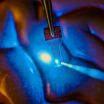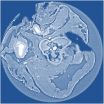(Press-News.org) DURHAM, N.H. –- Crewed missions to Mars remain an essential goal for NASA, but scientists are only now beginning to understand and characterize the radiation hazards that could make such ventures risky, concludes a new paper by University of New Hampshire scientists.
In a paper published online in the journal Space Weather, associate professor Nathan Schwadron of the UNH Institute for the Study of Earth, Oceans, and Space (EOS) and the department of physics says that due to a highly abnormal and extended lack of solar activity, the solar wind is exhibiting extremely low densities and magnetic field strengths, which causes dangerous levels of hazardous radiation to pervade the space environment.
"The behavior of the sun has recently changed and is now in a state not observed for almost 100 years," says Schwadron, lead author of the paper and principal investigator for the Cosmic Ray Telescope for
the Effects of Radiation (CRaTER) on NASA's Lunar Reconnaissance Orbiter (LRO). He notes that throughout most of the space age, the sun's activity has shown a clockwork 11-year cycle, with approximately six- to eight-year lulls in activity (solar minimum) followed by two- to three-year periods when the sun is more active. "However, starting in about 2006, we observed the longest solar minimum and weakest solar activity observed in the space age."
These conditions brought about the highest intensities of galactic cosmic rays seen since the beginning of the space age, which have created worsening radiation hazards that potentially threaten future deep-space astronaut missions.
"While these conditions are not necessarily a showstopper for long-duration missions to the moon, an asteroid, or even Mars, galactic cosmic ray radiation in particular remains a significant and worsening factor that limits mission durations," says Schwadron.
The study is the capstone article in the Space Weather CRaTER Special Issue, which provides comprehensive findings on space-based radiation as measured by the UNH-led detector. The data provide critical information on the radiation hazards that will be faced by astronauts on extended missions to deep space such as those to Mars. The papers can be viewed here: http://onlinelibrary.wiley.com/10.1002/(ISSN)1542-7390/specialsection/CRATER1
"These data are a fundamental reference for the radiation hazards in near Earth 'geospace' out to Mars and other regions of our sun's vast heliosphere," says Schwadron.
At the heart of CRaTER is material called "tissue equivalent plastic"—a stand-in for human muscle capable of gauging radiation dosage. Ionizing radiation from galactic cosmic rays and solar energetic particles remains a significant challenge to long-duration crewed missions to deep space. Human beings face a variety of consequences ranging from acute effects (radiation sickness) to long-term effects including cancer induction and damage to organs including the heart and brain.
The high radiation levels seen during the sun's last minimum cycle limits the allowable days for typical astronauts behind spacecraft shielding. Given the trend of reducing solar output, the allowable days in space for astronauts is dropping and estimated to be 20 percent lower in the coming solar minimum cycle as compared to the last minimum cycle.
UNH coauthors on the capstone paper titled "Does the worsening radiation environment preclude future manned deep-space exploration?" include Colin Joyce, Martin Lee, Charles Smith, Sonya Smith, Harlan Spence, and Jody Wilson.
INFORMATION:
The CRaTER investigation is a collaboration with team members at UNH, the University of Tennessee at Knoxville, Southwest Research Institute, Harvard-Smithsonian Center for Astrophysics, The Aerospace Corporation, the University of Michigan, and NASA Goddard Spaceflight Center. For more information on the CRaTER instrument and the LRO mission, visit http://crater.unh.edu.
Support for this research comes from NASA's LRO/CRaTER mission, and NASA'S Earth-Moon-Mars Radiation Environment Module and Corona-Solar Wind Energetic Particle Acceleration projects. Additional support is provided by the National Science Foundation's Frontiers in Earth-System Dynamics program, which funds the UNH-led "Sun-to-Ice" project that uses theory and modeling results to inform the analysis of current space-based NASA measurements of the radiation environment.
The NASA Goddard Space Flight Center in Greenbelt, Md. developed and manages the LRO mission. LRO's current science mission is implemented for NASA's Science Mission Directorate. NASA's Exploration Systems Mission Directorate sponsored LRO's initial one-year exploration mission that concluded in September 2010.
The University of New Hampshire, founded in 1866, is a world-class public research university with the feel of a New England liberal arts college. A land, sea, and space-grant university, UNH is the state's flagship public institution, enrolling 12,300 undergraduate and 2,200 graduate students.
Images to download: http://www.eos.unh.edu/Spheres_1012/graphics/fall12_pics/prediccs2_lg.jpg
Caption: Solar flare observed by the Reuven Ramaty High Energy Solar Spectroscopic Imager and associated coronal mass ejection observed by the Solar and Heliospheric Observatory spacecraft. Solar energetic particles from these events can easily penetrate typical shielding and damage spacecraft electronics and biological cells. Image courtesy of Nathan Schwadron, UNH-EOS.
http://www.eos.unh.edu/Spheres_0312/graphics/spr12_pics/lro_lg.jpg
Caption: Artist's rendition of the Lunar Reconnaissance Orbiter at the moon. The CRaTER telescope is seen pointing out at the bottom right center of the LRO spacecraft. Illustration by Chris Meaney/NASA.
DURHAM, N.H. – Six percent of U.S. children and youth missed a day of school over the course of a year because they were the victim of violence or abuse at school. This was a major finding of a study on school safety by University of New Hampshire researchers published this month in the Journal of School Violence.
"This study really highlights the way school violence can interfere with learning," says lead author David Finkelhor, professor of sociology and director of the Crimes Against Children Research Center (CCRC) at UNH. "Too many kids are missing school ...
New research shows that a preservation technique known as sequential subnormothermic ex vivo liver perfusion (SNEVLP) prevents ischemic type biliary stricture following liver transplantation using grafts from donations after cardiac death (DCD). Findings published in Liver Transplantation, a journal of the American Association for the Study of Liver Diseases and the International Liver Transplantation Society, indicate that the preservation of DCD grafts using SNEVLP versus cold storage reduces bile duct and endothelial cell injury post transplantation.
The shortage ...
VIDEO:
Scientists at the US Department of Energy's Ames Laboratory modeled the 'passing probability' of molecules within the narrow pores of mesoporous nanoparticles. This understanding will help determine the optimal diameter...
Click here for more information.
Scientists at the U.S. Department of Energy's Ames Laboratory have developed deeper understanding of the ideal design for mesoporous nanoparticles used in catalytic reactions, such as hydrocarbon conversion to biofuels. ...
ATLANTA—Animal-assisted therapy can reduce symptoms of anxiety and loneliness among college students, according to researchers at Georgia State University, Idaho State University and Savannah College of Art and Design. Their findings are published in the latest issue of the Journal of Creativity in Mental Health.
The researchers provided animal-assisted therapy to 55 students in a group setting at a small arts college in the Southeast. They found a 60 percent decrease in self-reported anxiety and loneliness symptoms following animal-assisted therapy, in which a ...
MADISON, Wis. — Developing invisible implantable medical sensor arrays, a team of University of Wisconsin-Madison engineers has overcome a major technological hurdle in researchers' efforts to understand the brain.
The team described its technology, which has applications in fields ranging from neuroscience to cardiac care and even contact lenses, in the Oct. 20 issue of the online journal Nature Communications.
Neural researchers study, monitor or stimulate the brain using imaging techniques in conjunction with implantable sensors that allow them to continuously ...
WASHINGTON D.C. Oct. 21, 2014 -- The most obvious effects of too much sun exposure are cosmetic, like wrinkled and rough skin. Some damage, however, goes deeper—ultraviolet light can damage DNA and cause proteins in the body to break down into smaller, sometimes harmful pieces that may also damage DNA, increasing the risk of skin cancer and cataracts. Understanding the specific pathways by which this degradation occurs is an important step in developing protective mechanisms against it.
Researchers from the École Polytechnique Fédérale de Lausanne ...
By analysing DNA extracted from the petrous bones of skulls of ancient Europeans, scientists have identified that these peoples remained intolerant to lactose (natural sugar in the milk of mammals) for 5,000 years after they adopted agricultural practices and 4,000 years after the onset of cheese-making among Central European Neolithic farmers.
The findings published online in the scientific journal Nature Communications (21 Oct) also suggest that major technological transitions in Central Europe between the Neolithic, Bronze Age and Iron Age were also associated with ...
WASHINGTON, D.C., October 21, 2014 -- X-ray phase tomography is an imaging technique that uses penetrating X-rays to create volumetric views through "slices" or sections of soft biological tissues, such as tumors, and it offers strongly enhanced contrast compared to conventional CT scans. Yet scientists still do not know which X-ray phase tomography methods are best suited to yield optimized results for a wide variety of conditions.
To answer this question, a large group of researchers in Europe set out to compare three different X-ray phase tomography methods at the ...
WASHINGTON, D.C., October 21, 2014 -- Hikers are generally advised that the weight of the packs they carry should correspond to their own size, with smaller individuals carrying lighter loads. Although petite backpackers might appreciate the excuse to hand off heavier gear to the larger members of the group, it turns out that they may not need the help.
While leading students on extended backpacking trips for Outward Bound, Kansas State University physics professor Michael O'Shea noticed that some of the smaller students could comfortably carry a greater pack weight than ...
VIDEO:
Chapman University has initiated the first comprehensive nationwide study on what strikes fear in Americans in the first of what is a planned annual study. The Chapman Survey on American...
Click here for more information.
ORANGE, Calif. – Chapman University has initiated the first comprehensive nationwide study on what strikes fear in Americans in the first of what is a planned annual study. According to the Chapman poll, the number one fear in America today ...







